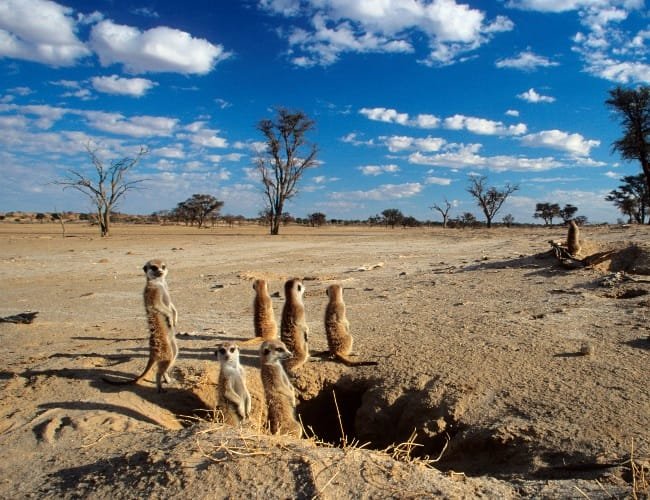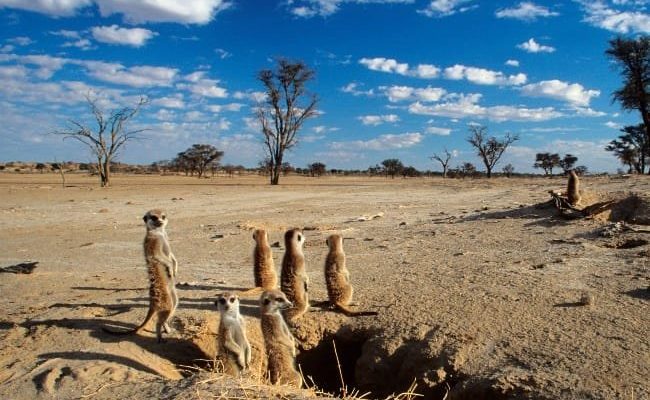
Imagine a vast, sun-soaked landscape where these small, social mammals roam freely, digging tunnels and interacting with their family groups. Meerkats are native to the southern regions of Africa, and their habitat is as unique as they are. From arid deserts to grassy plains, these little creatures have adapted beautifully to their surroundings. Here’s the thing: understanding where meerkats live helps us appreciate their role in the ecosystem and the qualities that make them special.
Meerkat Habitats: A Closer Look
Meerkats primarily inhabit *dry, open grasslands* and *deserts*, particularly in southern Africa. Think of places like the Kalahari Desert, which stretches across Botswana, Namibia, and South Africa. These areas might seem harsh for life, but meerkats have some remarkable adaptations. They dig complex burrows that provide shelter and protection from predators and extreme temperatures.
In fact, a meerkat burrow can have multiple entrances and chambers, functioning like a cozy underground home. They spend time “guarding” the entrance, keeping an eye out for predators like eagles and snakes while the rest of the gang forages for food. It’s all about teamwork!
Meerkats use their burrows not just for sleeping but also for raising their young. Each group, or mob, usually has about 20 members, and they work together to take care of the babies—a bit like a big, happy family.
The Kalahari Desert: The Heart of Meerkat Territory
Let’s zoom in on the Kalahari Desert. This striking region is largely sandy and dry, making it an ideal home for meerkats. These little critters are so well-adjusted to their environment that they can go for long stretches without water—refreshing, right? Instead, they get most of the moisture they need from the insects and plants they munch on.
You might be wondering, “How do meerkats stay safe in such an open landscape?” It’s all about their social structure. They rely on one another for protection, with one or two meerkats acting as sentinels while others forage. This lookout system is essential for avoiding predators.
Their social behavior is fascinating, too! Not only do meerkats communicate through a variety of vocalizations, but they also use body language to convey messages within the group. When they sense danger, they can quickly alert each other, making their social bonds even stronger.
Other Habitats: Beyond the Desert
While the Kalahari Desert is a primary habitat, meerkats can be found in other areas too. They thrive in parts of Namibia and South Africa, particularly in regions like the Namib Desert and the Cape regions. These habitats may not be as harsh as the Kalahari, but they still present challenges.
In these varied environments, meerkats adapt their foraging techniques. They eat a diverse diet that includes insects, fruits, and even small reptiles. Their ability to adapt to different food sources is a testament to their resilience. Imagine a meerkat exploring new territories, discovering delicious treats along the way!
Their ability to thrive in varied habitats also plays a vital role in their survival. If one area faces challenges like drought or food scarcity, they can migrate to other regions where resources are more plentiful.
Climate Adaptations: Survival of the Fittest
The climate where meerkats live is often characterized by extreme conditions—hot during the day and quite cold at night. This wide-ranging temperature difference requires adaptability, and meerkats have that in spades. During the heat of the day, they burrow into the cool underground tunnels to escape the sun. It’s kind of like having a personal, climate-controlled escape!
Here’s the thing: meerkats don’t just rely on their burrows for temperature control; they also partake in social grooming and sunbathing. By snuggling up to one another, they stay warm and connected, reinforcing their social bonds.
Surprisingly, they can also be quite flexible in their daily activities. While most of their foraging happens during the cooler parts of the day, you might see them out and about during the early mornings and evenings. This behavior helps them avoid the harsh midday sun, showcasing their adaptability.
Impact of Human Activity on Meerkat Habitats
You might be worried about how human development impacts meerkats. As with many wild animals, habitat destruction due to agriculture, urbanization, and climate change poses significant threats. When their environment is affected, it can lead to decreased food resources, making it tough for these little guys to thrive.
Some meerkat populations are more resilient than others, but it’s essential to keep an eye on how we affect their habitats. Conservation efforts are crucial, as they help ensure that meerkats and their ecosystems can survive. Supporting wildlife conservation organizations can make a difference, so consider getting involved!
Meerkats are often featured in documentaries and zoos, which helps raise awareness about their plight. You might love seeing them on a nature program, observing their quirky behavior and social interactions. Understanding their habitats can foster a deeper connection and appreciation for these fascinating animals.
So, where do meerkats live? In a nutshell, they thrive in dry, open grasslands and deserts, particularly in areas like the Kalahari Desert. These remarkable creatures have evolved unique behaviors and adaptations that allow them to survive in these sometimes harsh environments. By digging extensive burrows and working as a team, they create a vibrant community that illustrates the beauty of social structure in the animal kingdom.
As we learn more about where meerkats live and the challenges they face, we can better appreciate the need for conservation efforts. By protecting their habitats, we can ensure that future generations will continue to marvel at these amusing, curious animals. So next time you see a meerkat, remember the intricate world they inhabit—a place that’s worth every bit of our attention and care.

